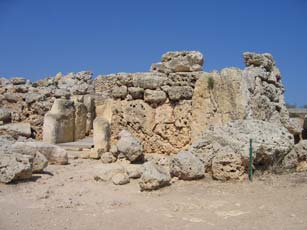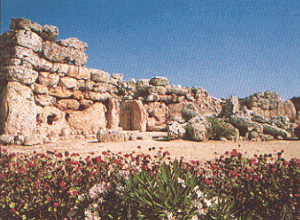| |
|
| |
 |
|
| Ggantija Temples |
| |
|
From about 4500 BC, people in Europe began building monuments of massive, standing stones, called megaliths. These were placed in circles or upright one next to the other, with another stone laid horizontally on top.
Stones were laid out very carefully, according to strict mathematical rules, but no one is sure what they were used for. They may have been eary observatories for studying the Sun, Moon, and stars, or TEMPLES where religios ceremonies were held. Experts also think that sacrifices, both human and animal, may have taken place inside these intriguing circles of stone. |
 |
|
| |
|
Stone henge in England is the most famous stone circle of all. Built in three stages, from about 2800BC, the stones were positioned to align preciselly with the sun on Midsummers Day. Other stones aloign with the phases of the moon, which suggests that stonehenge may have been a gigantic calendar.
A Mother Goddess figure made of clay and found at the Hypogeum, a megalithic monument the island of Malta. The Hypogeum was built deep underground, carved out of rock. |
| |
|
 |
The megalithic temples of Ggantija near the village of Xaghra are an outstanding example of the prehistoric monuments to be found on the Maltese Islands. According to latest analysis they were built around 3600 BC, earlier than the first pyramid in Egypt (around 2800 BC) and Stonehenge in England (around 2400 BC).
The temples' gigantic rocks weigh several tons and those used in the outer walls reach as high as six metres. How the people of those days were able to move them with their primitive tools is a mystery. According to local legend, a female giant called Sunsuna carried the rocks on her head from Ta' Cenc, a considerable distance away.
|
|
| |
|
|
The seting of these pre- historioc temples, affording a glorious panorama over a wide sweep of Gozo, is worth a visit in itself. Ggantija means gigantic and there is a legend that the temple complex was built by a fema called Sunsuna ..a giant who carried the stone blocks on her head from Ta Cenc. When you see the size of the megaliths you will understand why it was assumed that no mere mortal could possibly have moved them. The outer walls of the temples are built with colossal horizontal and upright blocks, some of them a height of 7. 5m and weighing up to 50 tonnes. According to latest analysis they were built around 3600 BC, earlier than the first pyramid in Egypt (around 2800 BC) and Stonehenge in England (around 2400 BC). It is impressive for its state of preservation.
The Temple interior consists of a smooth walled limestone passage leading to the five apses; here you can see the remains of altars where rituals were celebrated and animals slaughtered. The blocks across the central apse formed the main altar and its was here that two stone heads, probably representing the goddess of fertility, were, unearthed (they are now in the museum of Archaeology in Victoria)
|
| |
|
The apse to the left has two libation holes hewn out of the limestone at the rear of the limestone at the rear of the of the chamber and on the right there is a curious hole at the monolith which may have been an oracle hole. Another apse contains the so called 'Pubic Triangle~ which was once partnered by the stonephallus that is also in Victoria's Museum of Archaeology.
In addition to Ggantija there are other interesting sites. For example, there is the 'menhir' at Qala, a second temple close to Ggantija and temples at both tal-Qighan and ta' Marziena. At Ta' Cenc one can find what are thought to be prehistoric cart ruts etched deep into the hard rock and leading off the cliff edge. Their origins and use have still to be established. |
|
|
| |
|
|
|
 |










